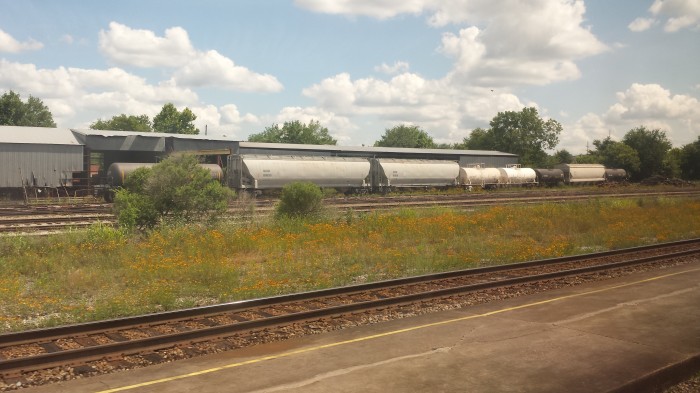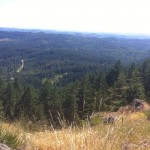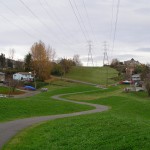
Last week, I took a train trip from Atlanta to New Orleans. You can read a little more about that here and here, plus I will probably write more about the experience of being in New Orleans, as it absolutely deserves its own post (or several). Right now though I want to talk a little bit about traveling, the process of going from one place to another, and perspective…especially what I am going to call the “medium-sized picture.”
Our language exhibits a bias towards “the big picture.” We are often admonished to remember it, and someone who fails to do that is described as being “unable to see the forest for the trees.” The big picture, grand, distant, seen from a lofty height, is obviously where it’s at. I might point out here that forests are made from trees, and that there are important differences between a temperate deciduous forest, an evergreen forest, and a tropical rain forest. If you can’t see the trees, you don’t know what forest you’re in. Without belaboring the metaphor, this also puts me in mind of the world-view that places transcendence, enlightenment, and detachment from the world above every-day life. There’s nothing wrong with a bit of big picture…indeed, it’s terribly useful at times. It’s just not everything.
There is also, of course, looking at things up close. You might call this the Georgia O’Keefe perspective; along with the famous quote about it taking time she said, “If you take a flower in your hand and really look at it, it’s your world for a moment.” To really know something…a place, a person, a flower, a spiritual practice…sit down, look closely, be still, be patient. This too brings valuable insights. But the small picture, like the big one, is not where we live our every-day lives. Most days, we are riding in a car when we ought to be on the train.
Let me explain: Flying on an airplane gives you the big picture. You can see rivers, mountain ranges, vast swaths of countryside. It’s hard to know what you’re looking at sometimes, though. You have breadth of vision but no detail.
Walking allows for detail, and the slow pace allows for depth of observation. Sometimes, though, you miss an understanding of relationships, the broader ecosystem in which a tree or a flower or a person lives. Here’s the tree, and the forest; what lies over the ridge? Where is the water coming from? Where is it going?
Riding in a car ought to be a mix of both, traversing the landscape swiftly enough to see how one ecology blends into another but slowly enough to see details, breadth and depth in balance; but in practice it mostly isn’t so. Automobiles are encapsulated little worlds; the way that roads are built, and human structures are built around them, effectively seal you into an isolation booth out of which you only emerge into a succession of replica gas stations and fast-food joints. You can fight this of course (and I regularly do) but there’s a trade-off. A lifetime of getting off the Interstate onto the “blue highways” (thank you, William Least Heat-Moon) has taught me that while it’s a lot more fun and interesting to travel that way it also takes a lot longer and you will be very, very tired when you get there. And you still, if you’re driving, have to pay attention to the road which looks the same for miles and miles.
From a train though you can see the landscape passing by, but also focus on details. Proximity to what is beside the tracks and your relative height means you can see more than from a car, both big and small. I could see, riding from Atlanta, that north Alabama is very like north Georgia. In fact, because the Appalachians swing farther southward into Alabama, the landscape I traveled between Anniston and Birmingham was very much like where I grew up in the most northwest corner of Georgia: ridges, valleys, rocky faces showing layers of sediment hundreds of millions of years old, forests of pine and a variety of deciduous trees with a dense understory and bright sun filtering through from above, sudden clear rivers and streams with bottoms of exposed rock, sand, and mud. The trees, shrubs, and flowers were all familiar to me, life-long friends. Between Birmingham and Tuscaloosa the land was very like middle Georgia, where I have also spent a significant portion of my time: rolling hills, farms with fields interspersed with trees, broader and muddier rivers.
Past Tuscaloosa the geography changed; it became both flatter and swampier, the trees less dense. Pines ceded some of their territory to cypress, swamp grasses, and water hyacinths. I began to see flowers and plants I recognized but didn’t know from childhood, and some I didn’t know at all. This kept on nearly to New Orleans, where the landscape changed again to salt marsh and the Delta, glades of grass and brackish water, wide flat sky, and snowy egrets, then the shining expanse of Lake Pontchartrain before arriving in the magic city at last.
On the way I could see elder bushes, water hyacinths, and a million wildflowers in bloom, known and unknown. I could even, at times, see the tracks of critters in the muddy ditches beside the tracks: deer, rabbits, and raccoons. I could see small towns, too: sun-bleached shotgun houses, comfortable old down-towns with brick courthouses, the utilitarian and the whimsical and the abandoned. As a friend said, it was like a tour of America’s back yard.
I couldn’t see it all, of course. But I could see enough.
















